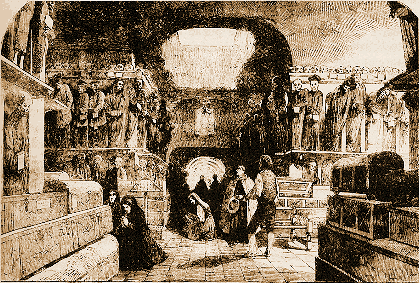Necropolis: New York Info

History:
The Necropolis' first hundred years was that of building, and of fortifying itself. This was not an easy task and one which claimed many wraiths to final death. Constant attacks
from spectres, and those wraiths who had existed here before them, the Hierarchy was quickly losing
the fight.
The council of Anacerons sent for reinforcements, what they got was a new government. This new government included a Council and a Governor, this at the time was
unheard of. The Governor, a Stygian hero named Jonas Smithee, took it upon himself to lead the Hierarchy
forces there. He quickly turned a losing fight, into a glorious victory, at the battle
of Amsterdam Bay. Here he crushed the indigenious wraiths, and made many of them thralls or soul-forged
equipment.
The next hundred years saw an era of peace and prosperity, as the
city grew, so did the Necropolis. It's importance as a harbor grew with each year,
and the Hierarchy forces there flourished. The Council began to gain more and more power away from the Governor. It was
their thinking that since the crisis was over, the Governor was of little use. Governor Smithee,
unable to stave off the loss of power, returned to Stygia in 1742.
The Revolutionary war had very much impact on the Necropolis as the
dead poured in from upstate New York. Many of these dead were British soldiers who wished to
return home to see their loved ones. It was then the the Council came up with the plan
to charge tarriffs, and fees on docking ships. With this plan in place the Necropolis began making
alot of it's income, enough to afford more legions, and more equipment.
The hundred years to follow was a time of great change, as many of
the Dark kingdoms began to send their Ambassadors to the city. Each took a domain and began to
reshape it into their way of death. The Coucil became fearful, believeing that the foreigners
would hurt their powerbase, chose to elect a Governor. Michael Whadsworth, the Anaceron of the Gaunt
Legion, took this oportunity to seize power, and made allies of the DK Ambassadors.
The Council could do nothing but elect him.
The new Governor began immediately to change the structure of the
city. Whether the Council agreed with his changes, or were unable to oppose him, is up for debate. Regardless,
Governor Whadsworth, organized the Hierarchy forces into their modern day incarnation. While
there had always been renegades, many point to Whadsworth's rule, as the first significant renegade
activity.
The New York Necropolis is one of the oldest in the New World. It's history dates back to it's first settlers. When it was once called New Amsterdam, the Hierarchy was taking
it's first steps into the Necropolizing of the Shadowlands. No one could have predicted this
tiny harbor towns' importance in later years.
During the twentieth century, Necropolis New York has seen the most changes. From the massive
immagration of the early 1900's to the two World Wars, New York has changed in size, contigency,
and renegade sympathy. The Hierarchy has had to adjust to these changes.
The first fifty years of the century were years of growth, and conflict.
Many immagrant wraiths were called upon to decide whether they were citizens of the Hierarchy,
or their native land. This lead to a few small skimishes between Hierarchy forces and the other Dark
Kingdoms over choice recruits. Nothing came of these skirmishes, and treaties were drawn
over the problem.
World War One's impact on the Necropolis was two fold, many resident
Legions left to help fight the war against the Code of Charon, and many renegade camps saw this as
a time to strike. Lines were drawn, and battles in the city were fought over territory, slavery,
and forges. Many renegade camps were successful in their conquest for domain, while
weaker camps were stamped out. The Hierarchy, seeing a need for strong leadership, ousted
the current Governor, and elected a new one. Governor Ian Mcdonald took the reins in 1916, and
quickly gained support from Stygia in the form of new Legions. Those renegade camps that were
once strong, became the number one targets. It took the Governor two years to push them back
into what was traditionaly renegade held domain.
World War Two, and Stygia's declaration of war against the Dark Kingdom
of Jade, had the Necropolis divided even further. There were open battles between the two
kingdoms on the streets of New York for three years, until the Jade Kingdom surrendered.
It was during this conflict that a young legionnaire named Deter, made his destiny.
Deter became the toast of the local Hierarchy for his daring, and
his uncanny ability to win lost battles. He became Anaceron of the Grim Legion in 1947, and it took him
only forty more years to gain enough support to become Governor.
The last ten years have been hard upon the Necropolis. The renegade
problem rising, Governor Deter declared Martial Law, and has enforced it to the letter. Justice has become
harsh, and the violent encounters between renegade and Hierarchy forces have only increased.
During the last two years, strange events hurled the Necropolis into war with the Blighted Sun.
The war proved costly and many Legionnaires, citizens, heretics and renegades lost their unlives to Oblivion. The war was finally
won due to the heroics of the entire Necropolis.




